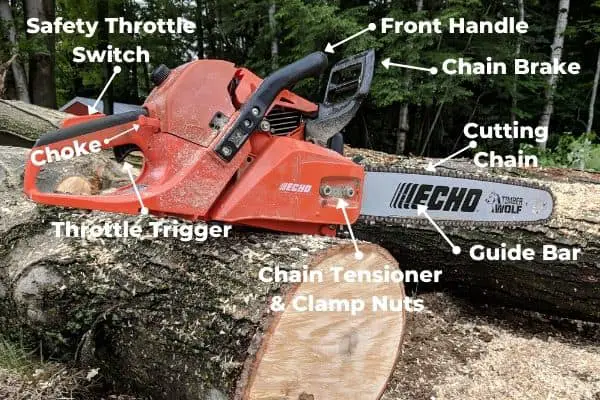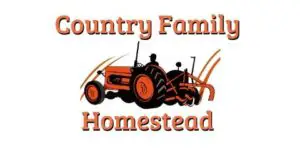It can be frustrating sometimes when you’re cutting wood and your chainsaw just doesn’t seem to want to cut straight. Your end result is an angled cut that makes it difficult for you to chunk up logs for something like firewood.
So, why does your chainsaw cut to the side?
- Your chain isn’t sharpened properly
- You might have the wrong type of chain on your bar
- Your guide bar might need to be replaced
- The rails on your guide bar are worn unevenly
These are a few things that can easily be fixed and get you back out there making the straight cuts you need. But there is still the question of how to fix it and the tools you need to do it.
Why Does My Chainsaw Cut Crooked?
More likely than not, your chainsaw needs a little bit of maintenance done to it. Like anything in life, in order to keep your equipment working properly, you’ll need to maintain the integrity of it. This includes, but is not limited to, your bar and chain of your chainsaw.
If the teeth of your chain have been regularly sharpened improperly, then you will end up with uneven teeth. Sharpening your chain’s teeth so that they line up evenly and are all the same length could be the only thing you might need to fix in order to get a straight cut.
If you still aren’t getting straight cuts after sharpening your teeth, you’ll want to double-check the chain you have installed on your guide bar is the correct chain. This is an easy spot, as a chain that doesn’t fit either wiggles or doesn’t fit in the groove correctly.
If your chain is the correct chain and it has been sharpened evenly and correctly, then the next thing you’ll want to look at is your guide bar. As you use your chainsaw, the groove on your guide bar gets worn down. Oftentimes, this groove gets too large to hold your chain.
Additionally, if your guide bar is perfectly fine, then you’ll have to inspect the rails of your guide bar. These are the ledges on either side of the groove. And just like the groove, as you use your chainsaw, the rails get worn down. Sometimes, the rails can be worn unevenly, and it will cause an angled cut.
How to Fix It
Instead of chucking your entire chainsaw in frustration and saying, “screw it”, we’ll go through a few steps to fix your chainsaw and make it cut like new.

Chain Improperly Sharpened
To sharpen the teeth of your chain, you will need to take a flat file and file each individual tooth in an inward angle while pulling it in a slightly upward movement. If you don’t file slightly upward, you will miss the cutting edge of the tooth and it won’t matter how even and sharp your teeth are, it won’t cut properly.
After you have filed all the teeth on one side, you’ll need to flip it around and file the teeth on the other side. This can be difficult for some people because it’s at an odd angle. A lot of people mess up here and file the teeth unevenly, so it’s important to pay close attention to what you’re doing on the opposite side.
A good quality sharpening kit like this one by Cataumet from Amazon.com will help keep your chains sharp and avoid improper techniques. The file handle system allows the user to keep the file level and apply steady pressure.
Wrong Type of Chain Installed
The guide bar you have on your chain saw must be a specific size, and because of this, the chain needs to be a specific size as well. The guide bar groove measures a specific width. So, for your chainsaw to cut properly, the chain drivers need to be the same thickness of the groove in the guide bar. The chain drivers are the little teeth on the inside of the chain that resemble shark teeth.
An easy way to spot this is by wiggling the chain side to side inside the bar. If the movement is extreme or more than normal than the chain isn’t seated properly and doesn’t fit the guide. To fix this you will need to replace your old chain with the proper size chain.
Guide Bar Mishaps
A chainsaw needs regular maintenance. One of the things that need to be looked at regularly is the bar. If the bar is too worn, then the chain won’t sit inside the groove properly. To fix this you will need to flip your guide bar over after every few blade sharpenings. This assures that the wear on the bar is evenly distributed.
If you wiggle your chain on the top and bottom sides of the bar, you will see that both sides have a different amount of movement. This is because one side has more wear than the other. One thing to remember is that it doesn’t matter if the top is looser than the bottom, because you’ll be cutting in a downward motion. If your chain is loose on both sides of the guide bar, then you will need to replace your bar altogether.
Uneven Rails
The most common of the issues that cause angled cuts is the guide bars railing. The railing on the guide bar is constantly worn because of the friction of the chain. Oftentimes, the wearing is uneven on either side, so it’s important to check this regularly. One way to check is by standing your guide bar up on a flat surface. If it stands up on its own then your rails are okay. If it tips over, you will need to file down your guide’s rails.
One option is to call your local machine shop to see if they have the equipment to grind metal. This will probably be expensive to have done, but you can take your guide into the shop to get your rails ground down evenly.
A less expensive option is to put your guide bar into a vice and run an axe file or flat file along it parallel to the ground until your rails are even. If you don’t feel comfortable doing that, you can buy a bar dresser, which is a small tool that is specifically made to maintain rails.
A bar rail dresser like this one from Oregon will help keep your bar rails flat and parallel and avoid the “knifing” that comes from uneven sharpening or just from general wear. You can check it out on Amazon.com
If it is majorly uneven, you will need to grind the rails down with a grinder until the uneven side is almost even with the other. From here, you will need to file it down to even it out the rest of the way with a file or a bar rail dresser. If it gets to this point though it may be time to replace the bar.
Chain Sharpening Personal Protective Equipment
When you are interacting with tools, it’s important to wear the proper personal protective equipment (PPE) to avoid injury. When you are filing your guide bars, it creates a razor-sharp edge that could easily, and cleanly slice right through your fingers. To avoid this, you can wear a pair of leather gloves and be careful to keep your fingers away from the guide while filing.
Another precaution to take is to wear proper eye protection. This one might not seem very important at first, but as you file away at your guide bar, you will see why it is. When you file at the metal of your guide bar, you will be creating very thin and extremely sharp shards of metal. These shards have a tendency to fly up at your face while you file. And to get one of those in your eye can be exceptionally painful.




